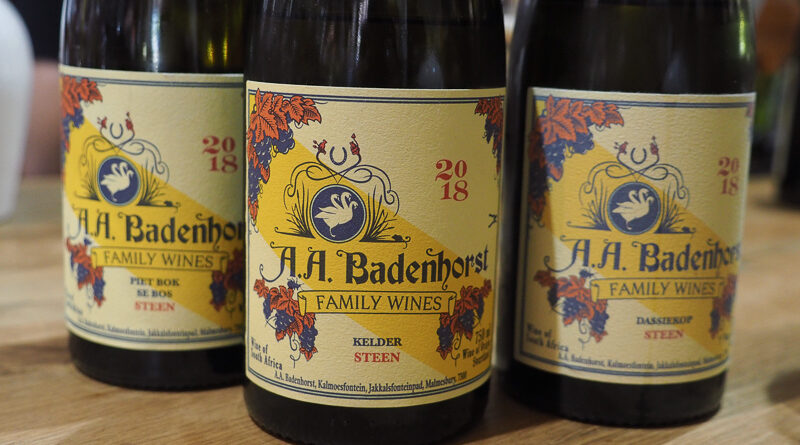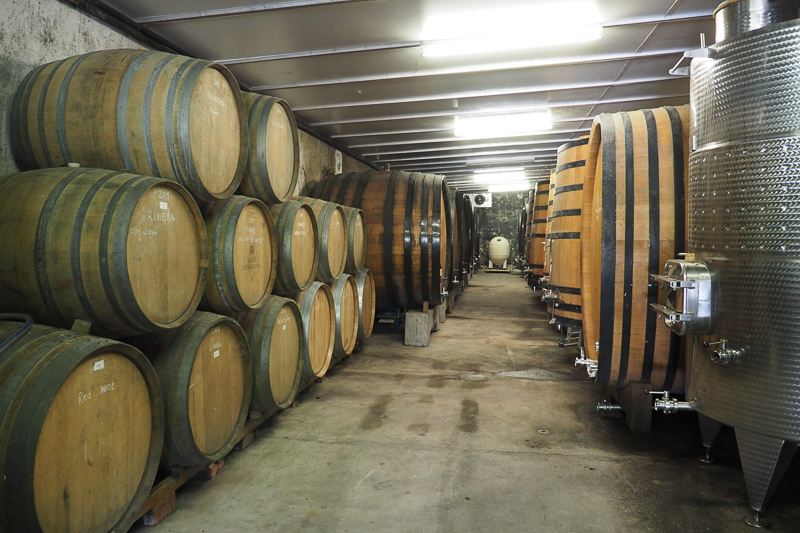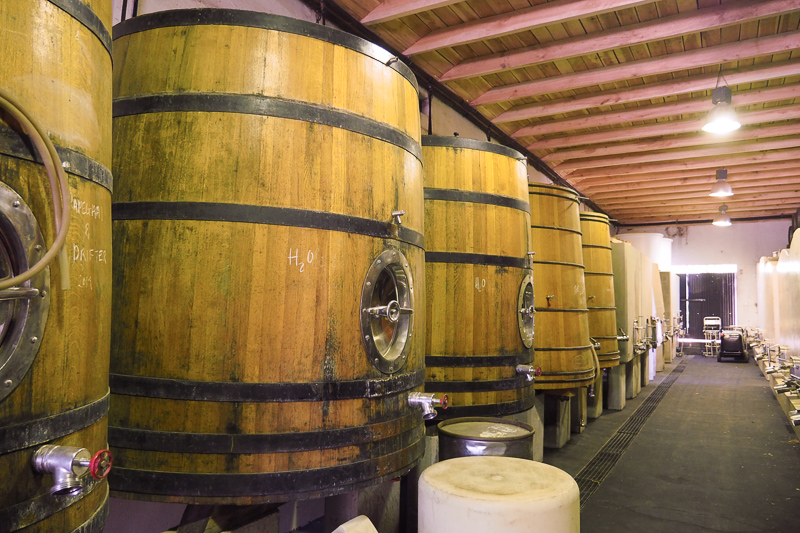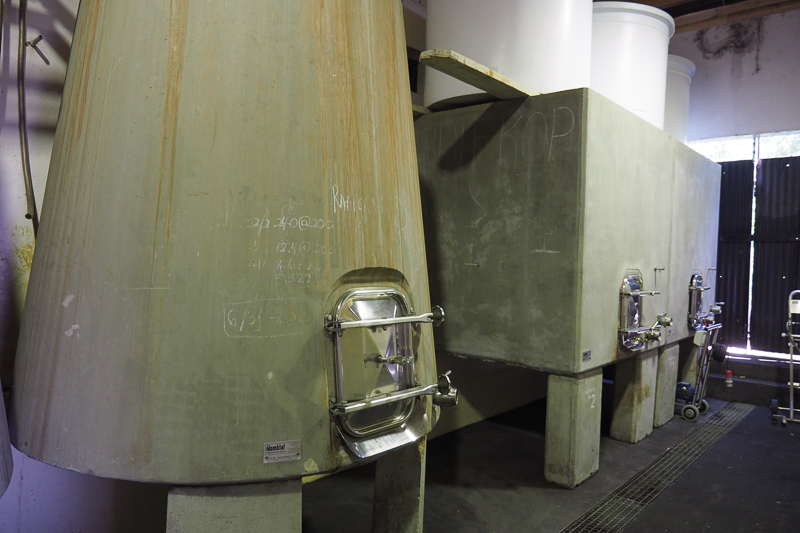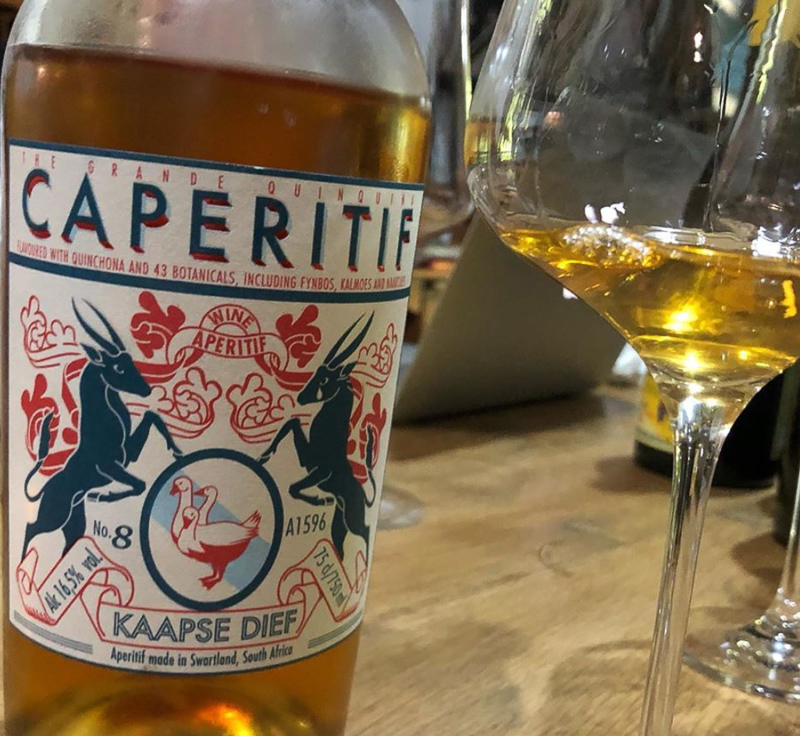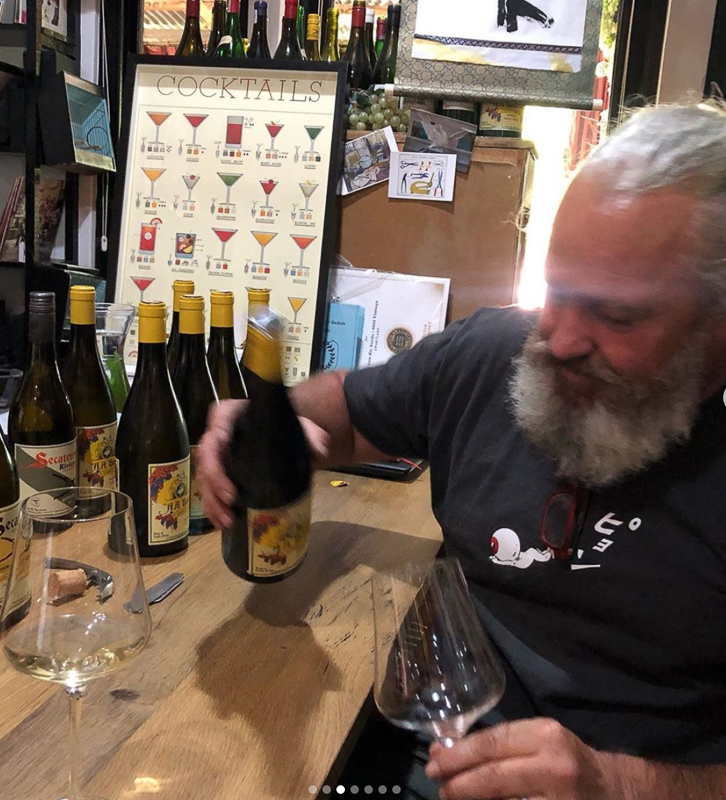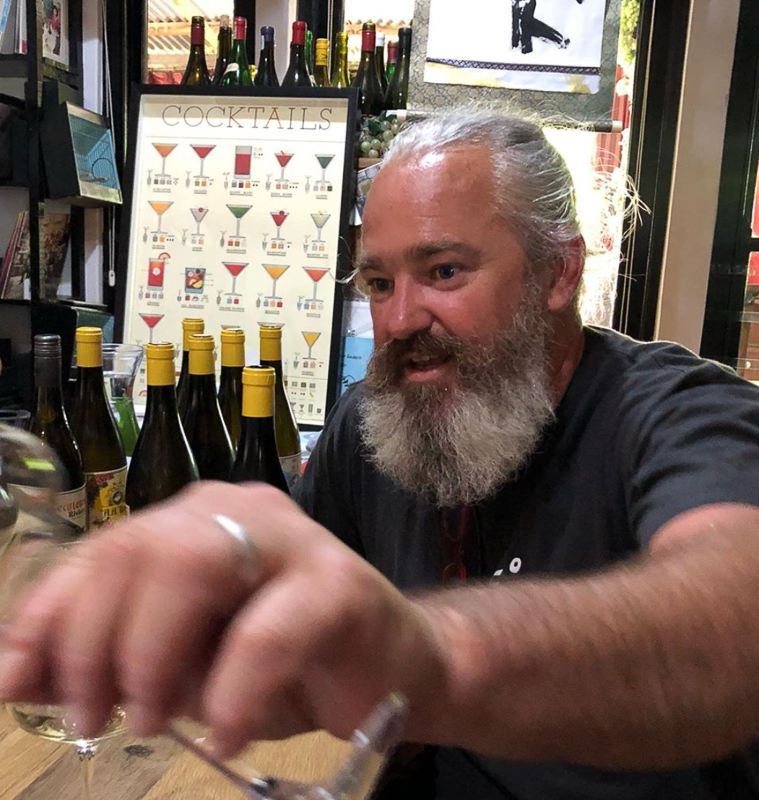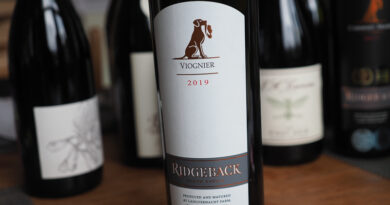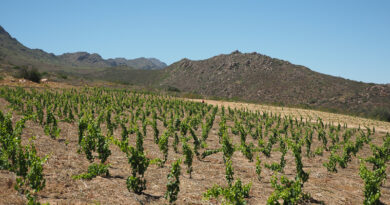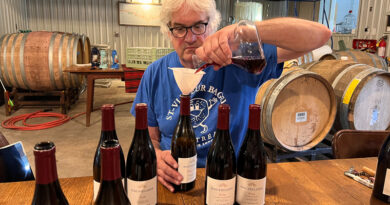In the Swartland: AA Badenhorst Wines
Goode and Ring visit Adi Badenhorst at his Kalmoesfontein farm in the Paardeberg
Wesbsite https://www.kalmoesfontein.com/
One of the most fascinating people in the South African wine scene is Adi Badenhorst. I first met him when he was winemaker at Rustenberg, and he showed me around the farm on a visit in 2005. But despite the fact that he was making some amazing wines there, things didn’t work out, and he left. Rustenberg’s loss was the Swartland’s gain, and he moved there and bought his farm, Kalmoesfontein, in 2007. It’s a 60 hectare property in the Paardeberg that he owns with his cousin. They have renovated an old wine cellar here, and added another, and this is where the Badenhorst wines are made.
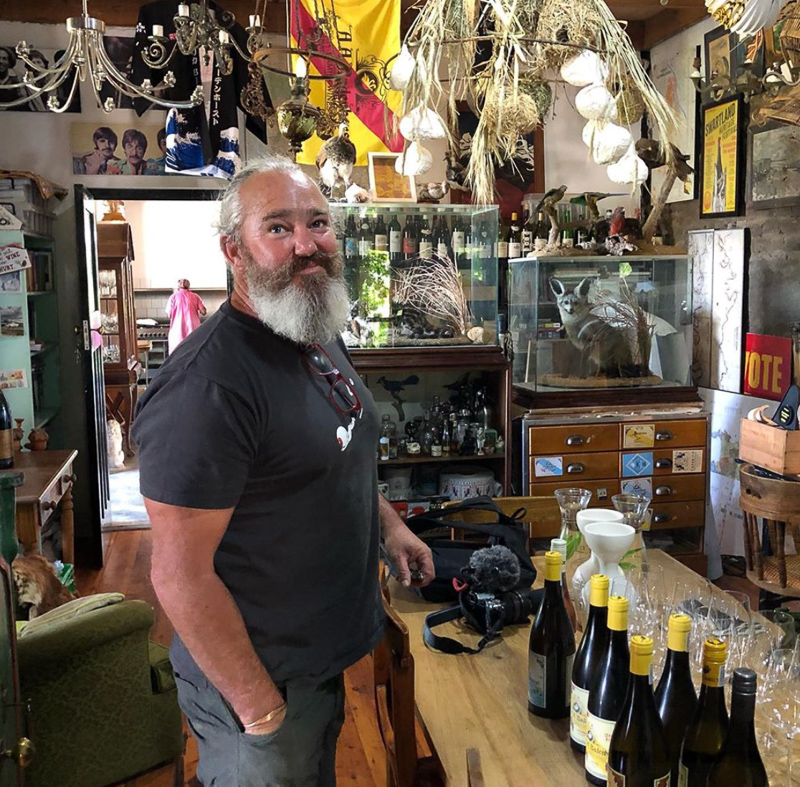
I’ve bumped into Adi many times over the years, but this was the first time I’d visited his place, though Ring had been previously. We were excited to see the farm that has produced so many interesting wines, and we visited with Adi and also his assistant winemaker Hanneke Botha.
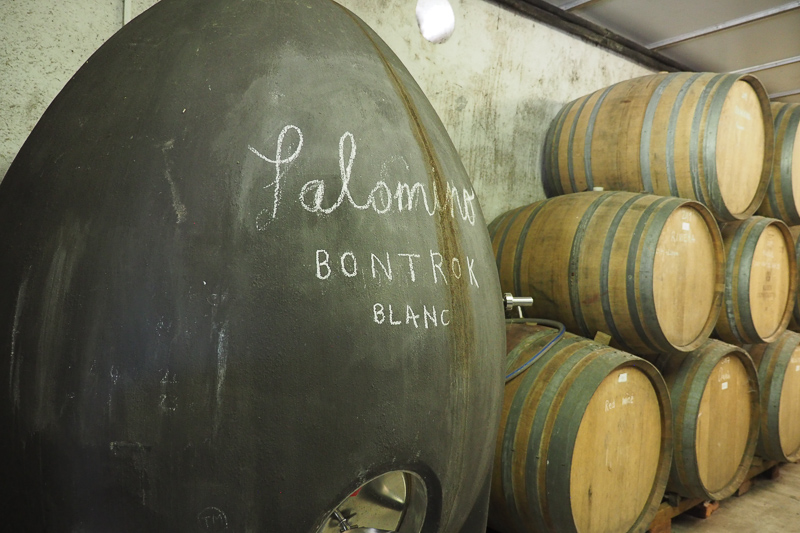
[One of my most memorable Adi experiences was when I was at Rootstock, the natural wine fair in Sydney, back in December 2014. We were chatting over some Caperitif – his brilliant vermouth – and he asked me what I was doing after Rootstock. I said that I had an itinerary planned to visit a number of the natural-minded producers at the fair. ‘Can I join you?’ he asked. So we went on a tour together, to the Macedon ranges, Melbourne, and Geelong. Adi is a brilliant travelling companion, although he did manage to lose his passport and wallet, so I had to sub him cash. He paid me back in wine. It was a fine arrangement.]
Kalmoesfontein has 28 hectares of old vines, and Adi supplements this by buying in some grapes.
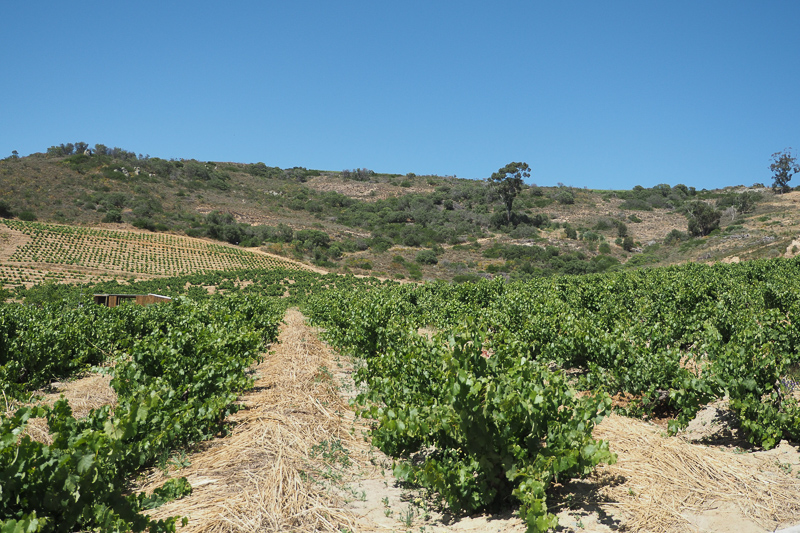
Many of the vats he has in the winery are second hand. He got some from Simonsig, and some from Eikendal, and even some concrete from Eben Sadie. ‘Eben upgraded his cellar,’ he says, ‘so I get all the leftovers.’ There are some old concrete tanks that were already present, along with some fermenters. His biggest tank is 7000 litres, but he needs 26 vessels to make up one blend of his Secateurs wine.
A short film of the visit:
We went to have a look at Adi’s Mezcal production. ‘I was in London in some dodgy Mexican restaurant drinking Mezcal. That stuff takes you close to the gates of Babylon very quickly, so I had to water it down. I put some tonic in it, and realized it is quite nice with tonic in it, and we make tonic [this is one of his sidelines, along with the fabulous Caperitif vermouth]. So we started making it.’ How did Adi learn? ‘I watched YouTube videos, but the trouble is my data always runs out, so I never reach the end.’
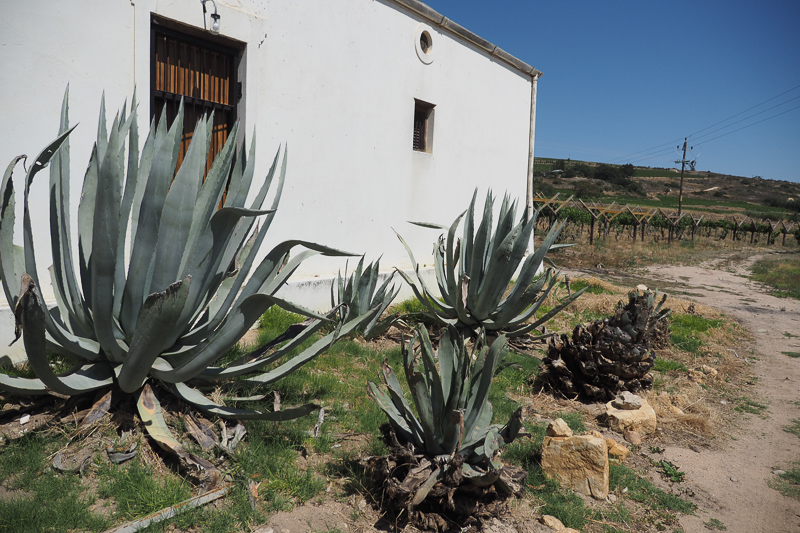
There’s a lot of agave in South Africa. ‘This is the blue agave,’ he says, pointing out one of the plants. ‘Agave americano.’ He dug a pit, started a fire, covered it in rocks, put the agave in and cooked it for 10 days. ‘When it comes out we put it through a shredder, and then into wooden vats.’ He adds some boiling water to draw out more sugar, and it starts to ferment. Then halfway through he adds a special yeast to get the alcohol to 4 or 5%. ‘We really don’t know what we are doing.’
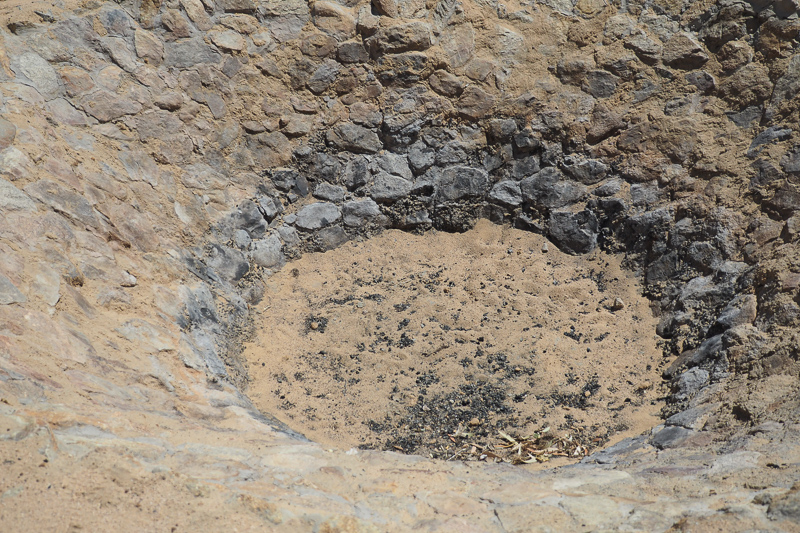
We also had a look at the Caperitif vermouth that he makes via solera. He’s just bottled batch number 9. There are some old lagares in this building, which is separate to the main winery. He ferments the agave in vats for 10 days, and then leaves it on husks and presses it after a couple of weeks. Adi says that he lent the press he uses to one of his friends, who then complained when he pressed his Grenache Blanc and it tastes of smoke from the residue of the agave on it.
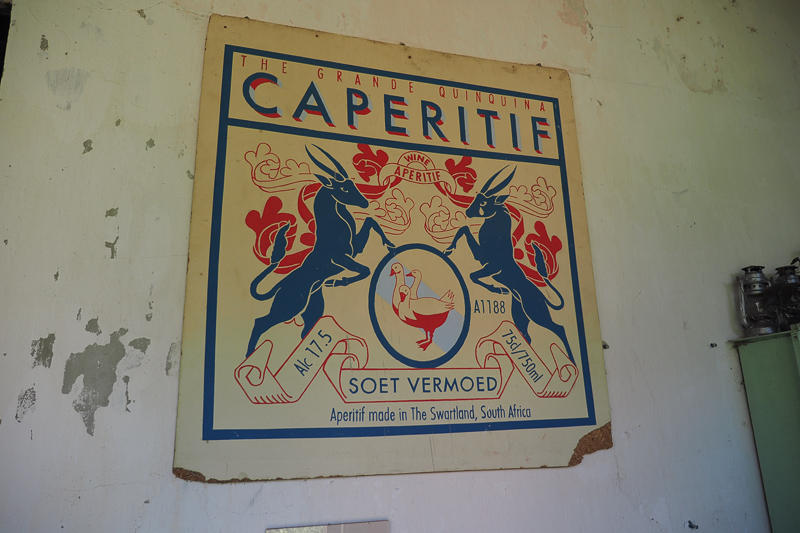
Just below this building there’s a five hectare plot that he’s going to plant to cork oaks. ‘It’s going to be very lekke,’ he says.
‘We make a lot of Chenin Blanc,’ says Adi. There are 16 different parcels of Chenin on the farm. ‘The vineyards are all quite different.’ They are mostly the same age, planted between 1966 and 1968.
‘We try to pick the vineyards within the same ripeness spectrum, and they are fermented in exactly the same way,’ says Adi. They are fermented in 1200 litre foudres that are 50-60 years old. ‘It’s a nice volume: the smaller vats have a little bit more impact.’ They are pressed directly into these foudres with no settling. The wines are bottled off their lees: Adi says that when the wine lies in a vat it is not homogenous, and he doesn’t want to disturb the lees, but sometimes there are differences in the bottles. The wine isn’t racked at all. The sulfur addition needs to be added quite a while before bottling, in winter, once the wine has finished malolactic.
The big production wine is the Secateurs Chenin Blanc, which is amazing value for money, and for which Adi buys in some grapes. ‘Without this thing we wouldn’t be able to do anything,’ he says. ‘We need it for our cashflow. It is from proper vineyards, and it’s properly done.’
Cashflow can be an issue. Adi says he has 822 customers in South Africa, and 60% of them take 120 days to pay. ‘I do go to a few restaurants and have a nice meal and then I say, thanks man, I’ll pay you next month. They say you can’t do that! I say ja, but I haven’t got the money now.’
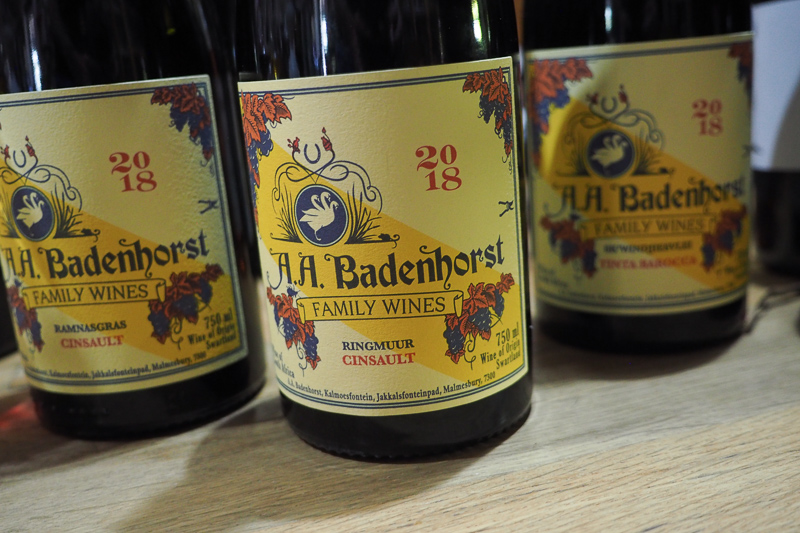
For the reds, when Adi does carbonic he puts the whole bunches in a plastic tank, then adds some fermenting juice just to get it going at the beginning. ‘Especially with Cinsault and whole bunch, it has quite high pH so I want it fermenting as soon as possible.’ There is a tank that has the first stuff that comes in, it starts fermenting, and he uses the juice from this to cross inoculate. ‘I remember when we first made wine here in 2009, it took 8 or 9 days for fermentation to start,’ he recalls. ‘I was beside myself. There was no yeast in the cellar.’ Now he says fermentation just starts.
The family red has two to three months on skins. The grapes are all picked together and cofermented. It is made in two tanks, which are then topped up after fermentation and left. ‘We normally press at the end of May,’ he says. It is mainly Shiraz (50%), with a bit of Touriga Nacional (a new addition). Shiraz is whole bunch, but Grenache and Cinsault are destemmed. Tinta Barocca is whole bunch.
Adi is a big fan of the Portuguese varieties in the Swartland. ‘I think they are amazing,’ he says. ‘They really do well. I have always bought a bit of Tinta Barocca, but now I’m getting used to farming it. It is a funny grower: it grows flat on the ground. I’m just trying to let it go and let it do what it wants to do. The way they have traditionally farmed it here is to top it quite early. It is a fantastic grape.’ As well as this, they have planted a bit of Alicante, Touriga and Bastardo on the farm. ‘They are doing very nicely.’
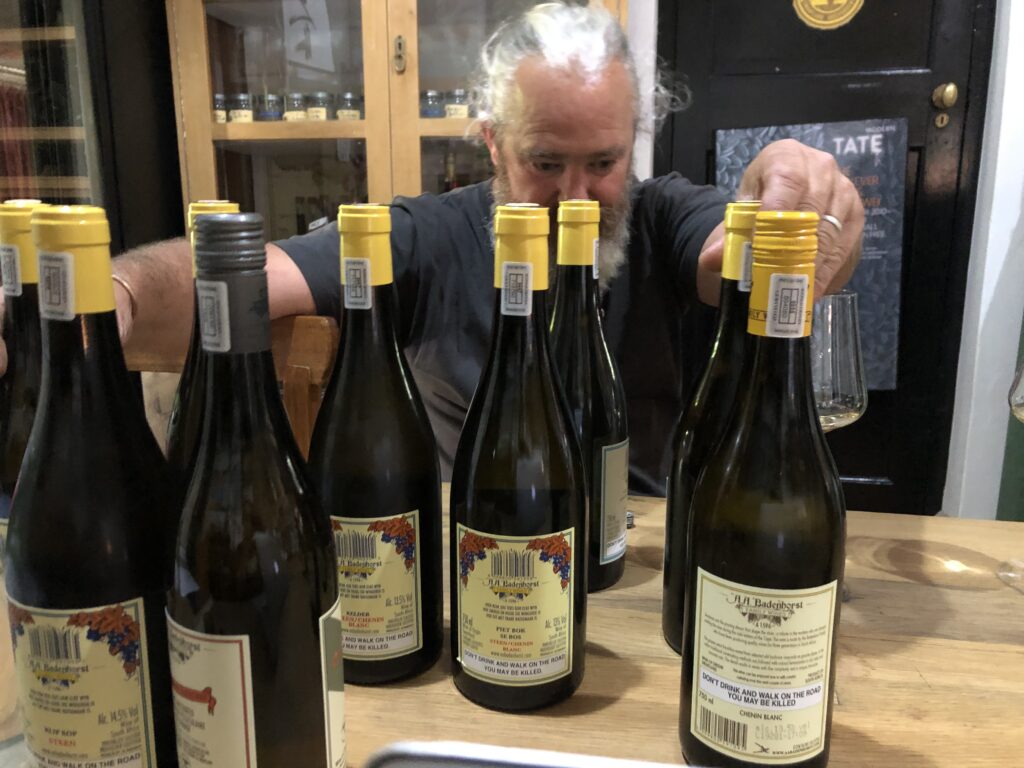
THE WINES
AA Badenhorst Sout Van die Aarde Palomino 2018 Swartland, South Africa
This translates as ‘salt of the earth, and there are two 500 litre barrels made. ‘The Palomino grape is every hipster’s wet dream at the moment,’ says Adi. This is from the same vineyard that Eben Sadie makes his Skerpioen wine from. This is bright, linear and salty with nice precision. Shows a lovely compact texture with lemon, fine herbs and some saltiness on the finish, as well as a ghost of spicy reduction (this starts off really reductive, because there is low nutrient levels in the juice). Lovely precision. 95/100 (JG)
“Every hipster’s wet dream”, this old vine Palomino is rooted in limestone soils, from 4 vineyards (one being the same vineyard as Sadie’s Skerpioen). Pressed into two 500L barrels, this spent 1 year in cask. Salty and tight, with a lovely reductive edge, this has great texture and edginess, with a lightness of being. 92/100 (TR)
AA Badenhorst Piet Bok Steen 2018 Swartland, South Africa
This is the only Chenin vineyard on the farm that is 100% Chenin, at the bottom of a slope, getting a bit of water so it’s a bit more vigorous. It has shallow-ish soils with some clay. This has amazing intensity with bright citrus and pear fruit, with some salinity and precision. Juicy and crystalline with some structure and fine spices. Some dried herb notes too, finishing with crisp citrus fruit. Linear and mineral. 95/100 (JG)
Situated at the bottom of a slope on his farm, this site collects the water in the shallower, clay soils. There’s a beauty elasticity and movement on the linear palate, shaping subtle melon, tangerine, and lemon pith to a lingering spiced finish. 92/100 (TR)
AA Badenhorst Kelder Steen 2018 Swartland, South Africa
This is made from the big vines near the winery from deep granitic sand, going down three metres. Haunting, delicate aromatics of lemons, herbs and a touch of cabbage. The palate shows fresh pear, melon and lemon fruit with subtle green hints adding to the perception of freshness. Bright with good acidity. 93/100 (JG)
Bigger sized vines, this vineyard has a little Palomino and Clairette throughout. The vines are rooted in 3m of granitic sand. More expansive on the palate, with fleshy pear, some dried quince, and green herbs. 91/100 (TR)
AA Badenhorst Dassiekop Steen 2018 Swartland, South Africa
1974 planting, on the farm next door at 300 m. Shallow granitic soils. This took 15 months to ferment. It has a harmonious, crystalline quality with sweet pear and white peach fruit. Elegant and restrained, but with some sweet fruit on the mid-palate. A real sense of elegance to this wine, with bright fruit at the core. 94/100 (JG)
These smaller, 1974 planted vines have some altitude at 300m, and are planted in granitic, shallow soils. This took 15 months to complete ferment. So salty and mineral on the nose, tight, nimble, and edgy, with quince, crunchy pear, and an alluring granitic grip that holds tight through the finish. Lightness and concentration = result. 94/100 (TR)
AA Badenhorst The Golden Slopes Chenin Blanc 2018 Swartland, South Africa
The highest vineyard on the farm at 300 m with a bit more clay on the soil. Rich and expressive with bold marmalade and spice notes. Has some ripe peachy fruit with nice depth of fruit. So powerful with an amazing spectrum of ripe fruit. Shows power as well as balance. 94/100 (JG)
From the highest vineyard on the farm around 300m, this is rooted in clay soils. Powerful and stately, with expansive yellow fruits, pear, and a warm wash of mineral salts on the finish. Grows in the glass. 92/100 (TR)
AA Badenhorst Klip-Klop (Haut-Granitika) Steen 2018 Swartland, South Africa
This vineyard is planted just on granitic rocks. Tiny vines, tiny bunches. Stony and mineral with lovely depth and tension. There are richer peachy, apricot notes but also a core of lemon and pear, with a complex mineral streak. Grapefruit and marmalade hints with a stony undercurrent. Quite profound. 96/100 (JG)
This vineyard is planted middle slopes on pure granitic rocks. Tiny vines and bunches can receive sun burn, resulting in textural tannins in the wine. Potent mineral salts, white pepper, on the tight and grippy palate, with quince and a brown butter / leather savoury note. Quite haunting, with exceptional length. 95/100 (TR)
AA Badenhorst Kalmosfontein White Blend 2017 Swartland, South Africa
One year in foudre, one year in concrete. This has a bit of everything in it. This is complex, mineral and stony with some lovely herbal hints alongside the white peach and pear fruit. Delicate and expressive but not lacking in concentration. Mineral with a fynbos edge, and a long, tapering, slightly saline finish. A lovely detailed wine, with depth and precision. 94/100 (JG)
Kalmoes is a water plant, used as a hallucinogen. This white blend comes from the same vineyards every year, and is Chenin based, joined with Marsanne, Roussanne, Grenache Gris, Grenache Blanc, Grenache Noir, Semillon Gris, Semillon Vert, Chardonnay, Verdelho, Viognier and Palomino. Picked and fermented together over 3 days, this then went into concrete. Quite Rhoneish, with great concentration and mouthfeel, this is dense with pear, melon, and ample, alluring honeysuckle. So much complexity here. 93/100 (TR)
AA Badenhorst Secateurs Chenin Blanc 2019 Swartland, South Africa
Adi buys in some grapes in for this. Pure, aromatic and fruity with mandarin and pear drop on the nose. Bright and fruity with nice freshness and lovely focused fruit. Has good acidity. 89/100 (JG)
Mostly from his farm’s unirrigated bush vines, this also uses purchased fruit (including from Jasper Wickens, David and Nadia). This large production wine was 15% skin fermented, and matured in cask and concrete on full lees for 7 months. Wild orange, ripe pear, melon, fennel, with a great fine spicing through the finish. This has juicy fruit sweetness (2.8 g/L RS) and is easy to enjoy without being dumbed down. 89/100 (TR)
AA Badenhorst Secateurs Riviera 2018 Swartland, South Africa
Specifically for the SAQ in Quebec. Chenin with some Semillon, with skin contact (2 weeks). Powerful with ginger and marmalade notes as well as bright pear fruit. Grippy structure with nice spicy detail. Very expressive and complex with good depth. 92/100 (JG)
An exclusive for Quebec’s monop, SAQ, this deep gold hued Chenin / Semillon was skin macerated for two weeks and went through full MLF. Highly perfumed with apricot and peach, this has some ash and big spices on the waxen palate. Concentrated and potent. 90/100 (TR)
AA Badenhorst Secateurs Rosé 2019 Swartland, South Africa
Mourvedre. This has a nice green tinge to the sweet cherry and berry fruit. Dry and gastronomic with a twist of sour cherry. Juicy and expressive with nice balance. 91/100 (JG)
Medium light pink hue, this Mourvèdre and Cinsault rosé opens with a big swing of reduction, leading to wild cherry, raspberry on the sticky-sided, juicy palate. Easy and uncomplicated; chill and crack. 88/100 (TR)
AA Badenhorst Secateurs Cinsault Shiraz Grenache 2018 Swartland, South Africa
Also has a bit of Chenin in here, and some other varieties. Everything picked together. Juicy and bright with sour cherries, plums and fine herbs. There’s a really appealing red fruit quality. Delicious stuff. 92/100 (JG)
Darting dark cherry, wild raspberry, wild plum, leather and big peppery spicing flood this medium red, a blend of Cinsault, Shiraz, and Grenache, with a little Chenin splashed in. Finely grippy tannins pin all in place. Over delivers. 91/100 (TR)
AA Badenhorst Ramnasgras Cinsault Swartland, South Africa
1960s plantings. Some whole bunch and destemmed. Fresh, pure and quite supple with juicy red fruits and notes of herb and spice. Compact and quite complex with nice freshness and purity. Has some grainy structure. 94/100 (JG)
From 1964 plantings, this Cinsault is wild and dusky with black raspberry, cherry, pomegranate, and sapid plum. Big grippy / sticky tannins hug this to the finish. 90/100 (TR)
AA Badenhorst Ringmuir Cinsault 2018 Swartland, South Africa
100% carbonic from 1960s plantings. Sweet, rounded and nicely herbal with some tea-like complexity to the smooth wild strawberry fruit with some cherry brightness. Lovely expressive wine with real personality and layers of flavour. 94/100
The clos. Entirely carbonic, this was done in plastic tank, with some fermenting juice to kick things off, then sealed it and closed for 3 weeks prior to pressing. From a plot closer to the house, this has juicy sweet cherry, and perfumed plum, with sticky tannins. Easy, youthful, and fun. 89/100 (TR)
AA Badenhorst Bokveld Pinot Noir 2018 Ceres Plateau, South Africa
Juicy, fine and sweetly fruited with some cherry and raspberry fruit. Silky mid-palate with some grippy, spicy tannins on the finish. Sour cherry notes. Juicy and detailed. 92/100 (JG)
From purchased fruit up in the mountain, this Pinot Noir carries soft raspberry, strawberry, forest berries on a pretty, spiced palate. Quite surprising. 91/100 (TR)
AA Badenhorst Sk’Windjiesvlei Tinta Barocca 2018 Swartland, South Africa
Grainy, grippy, dark and intense with vivid blackberry and black cherry fruit. Has lots of grippy tannin but the richness of the fruit carries things through. Floral and expressive. 93/100
AA Badenhorst Blend Shiraz, Cinsault, Grenache, Tinta Barocca Swartland, South Africa
50% Shiraz, whole bunches, as is Tinta Barocca, but the other varieties are destemmed. Complex, structured and expressive with nice grip to the sweet blackberry and black cherry fruit. There’s interesting structure from the extended maceration on skins. Has freshness and firm, grippy tannins, suggesting that this could develop very nicely. Has a slight minty hint, too. 94/100 (JG)
Shiraz (50%), Cinsault, Grenache, Tinta Barocca from the home farm was cofermented in 2 tanks with 3 months on skins, with the Shiraz snd the Tinta Barocca left whole bunch. Deep and generous, with dusky wild blackberry, anise, and mineral salts, this has firm, integrated grippy tannins and ample structure. 93/100 (TR)
Next we taste Adi’s Italian wine project, where he makes a Montepulciano from Abruzzo, and also a white.
A Mmàne Red 2017 Montepulciano d’Abruzzo, Italy
Just bottled. Concentrated and dense with lovely sour cherry, blackberry, black cherry and spice. Has tar and earth with lovely balance between the structure and the fruit, with a strong savoury component. Grippy, savoury, with tannic bite. Delicious stuff with amazing character. 94/100 (JG)
Dark and chewy, with dusky black raspberry, wild cherry, leather, and peppery spicing. Bitter cherry and chocolate lingers on the finish. Wild. 90/100 (TR)
A Mmaàne White 2017 Abruzzo, Italy
Pecorino, Trebbiano and Falanghina. Deep coloured with lovely sweet pear and peach fruit, with amazing depth and texture. Has richness but also restraint. So amazing. Lovely depth to this wine. 94/100 (JG)
Pecorino, Trebbiano, Falanghina have a little skin contact before resting 15 months on lees. Wax, smoke, wild orange and wild herbs stream across the textural palate, finishing with lingering meadow / herb note. 91/100 (TR)
Caperitif No 8
Powerful and intense. Very citrussy. Base wine is a white Muscadelle. Grapey richness with lovely tight herb and spice complexity. Sweet but with amazing balance. Lovely intensity and concentration. Marmalade, mint and spice on the finish. (JG)
Batch #8, this is based on Muscadelle, Hanepoot, and Chenin, and is infused with citrus, wild herbs, rosemary, sarsaparilla, fynbos, medicinal lemon, and white cherry, with dusky perfumed exotic spicing throughout. musky spicing. Now he’s fining with bentonite, and filtered. (TR)
The 4th Rabbit Karoo Agave Spirit
43% alcohol
Intense smoky nose. Complex, smoky, intense palate with refined spiciness. Lots of intensity but also good balance and focus. Long spicy finish. Really lovely. (JG)
Adi’s very local take on Mezcal. Lovely light smoked lemon, with big grippy spicing and alluring smoked notes through the finish. Intense. (TR)
Find these wines with wine-searcher.com

